ASUS Maximus Formula SE: X38 and DDR2 Unite!
by Rajinder Gill on November 9, 2007 7:00 AM EST- Posted in
- Motherboards
Air-Cooled and Subzero Benchmarks
ROG boards are designed to be raced (the extreme voltage ranges in BIOS hint at this), after "realist" testing. Any performance review is incomplete without taking at least a small benchmarking test drive with the pedal to the metal. We decided to find out just what the board would do with a "handpicked" E6850 CPU that is capable of high FSB speeds. Using air-cooling we managed to boot at 550FSB (3.85GHz), but did not manage to hold Super PI 32M stable using the 400 strap and 1:1 divider with 4-4-4-10 memory timings. We settled for 540FSB (3.78 GHz), again with the 400 NB strap using the 1:1 divider. Here are a few benchmark results:
E6850
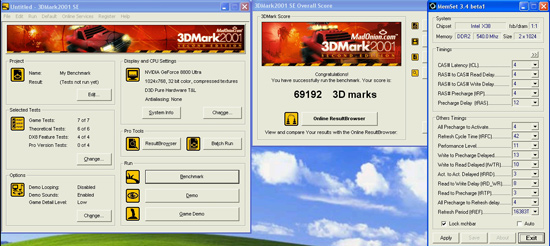
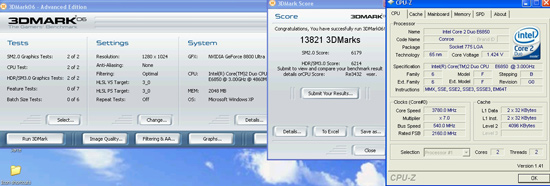
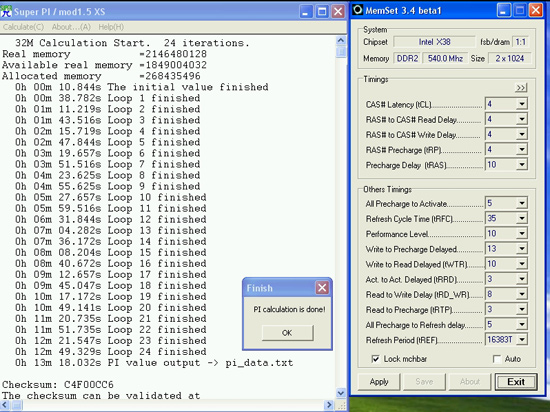
Using cascade cooling on both the CPU and GPU allowed benching in the region of 550-560FSB using the 9x multiplier. tRD (Performance Level) had to be set quite loose at 11-12 to provide stability for the benchmarks to pass. This is another area where ASUS is implementing core BIOS level changes to improve stability and memory performance in the higher FSB ranges. The DFI P35 board also reached 550FSB with this CPU but we were not able to hold the 550FSB level over the course of testing. We had to back off to the 540FSB range. This is the one key difference we have noticed between the two chipsets, the X38 will hold a higher FSB level over the course of extreme benchmarking than the P35.
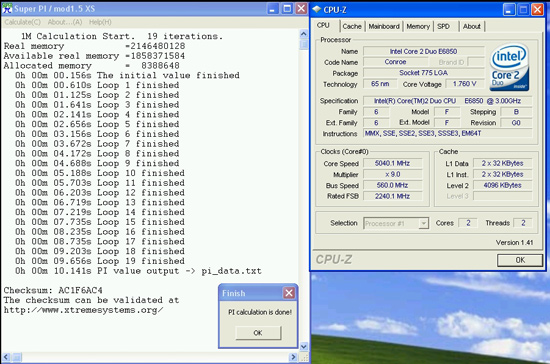
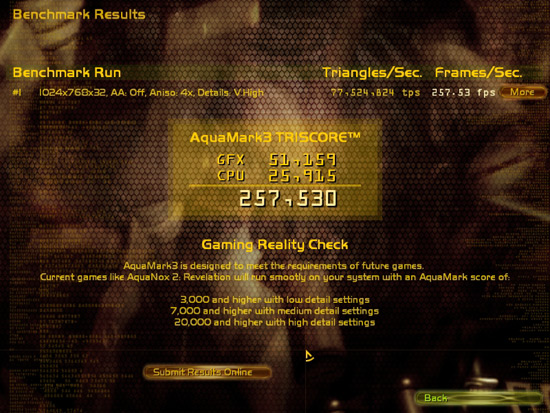
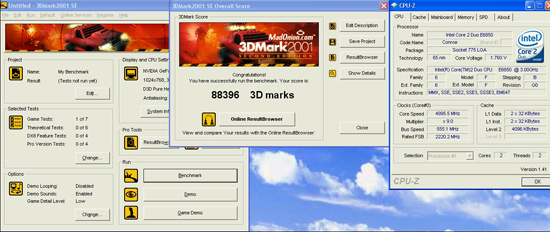
QX6800
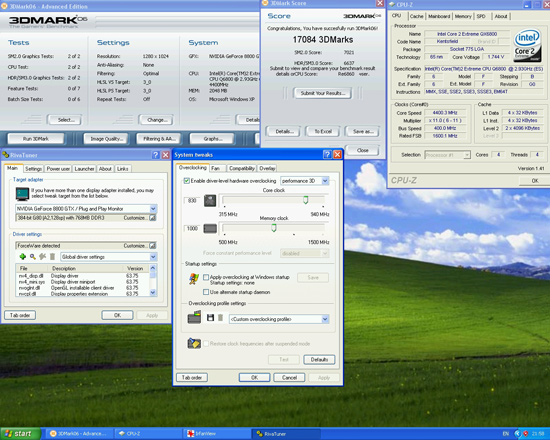
The Maximus Formula is certainly capable of holding high FSB/CPU MHz levels for extreme benchmarking. We also gave our cold bugged QX6800 G0 a little test spin with four cores active for a 3DMark06 session; unfortunately we were limited to around a 4400MHz CPU speed. This is not a problem with the motherboard; the CPU itself has been tested on many different boards with the same CPU MHz wall. These results surpass our DFI P35 slightly, indicating to us that the X38 is finally starting to mature and this board is a solid choice for overclocking, especially with a dual-core processor.
| ASUS Maximus Formula Overclocking Testbed |
|
| Processor | Intel Core 2 Duo E6850 - G0 Stepping Dual Core, 3.0GHz, 4MB Unified Cache, 9x Multiplier, 1333FSB |
| CPU Voltage | 1.300V Base |
| Cooling | Various - Tuniq Tower, Dual Rotary Cascade |
| Power Supply | PCP&C 1200W |
| Memory | OCZ Flex PC2-9200 (2x1GB) |
| Memory Settings | 4-4-4-12 (DDR2-1066) |
| Video Cards | MSI 8800 Ultra @ 702/1205, EVGA 8800 GTX 830-861/1000 |
| Video Drivers | NVIDIA 163.75 |
| Hard Drive | Western Digital 7200RPM 250GB - WD2500KS |
| Optical Drives | Plextor PX-755A |
| Case | Dimastech benching table |
| BIOS | ASUS 0505 |
| Operating System | Windows XP Professional - SP2 |
| . | |
ROG boards are designed to be raced (the extreme voltage ranges in BIOS hint at this), after "realist" testing. Any performance review is incomplete without taking at least a small benchmarking test drive with the pedal to the metal. We decided to find out just what the board would do with a "handpicked" E6850 CPU that is capable of high FSB speeds. Using air-cooling we managed to boot at 550FSB (3.85GHz), but did not manage to hold Super PI 32M stable using the 400 strap and 1:1 divider with 4-4-4-10 memory timings. We settled for 540FSB (3.78 GHz), again with the 400 NB strap using the 1:1 divider. Here are a few benchmark results:
E6850



Using cascade cooling on both the CPU and GPU allowed benching in the region of 550-560FSB using the 9x multiplier. tRD (Performance Level) had to be set quite loose at 11-12 to provide stability for the benchmarks to pass. This is another area where ASUS is implementing core BIOS level changes to improve stability and memory performance in the higher FSB ranges. The DFI P35 board also reached 550FSB with this CPU but we were not able to hold the 550FSB level over the course of testing. We had to back off to the 540FSB range. This is the one key difference we have noticed between the two chipsets, the X38 will hold a higher FSB level over the course of extreme benchmarking than the P35.



QX6800

The Maximus Formula is certainly capable of holding high FSB/CPU MHz levels for extreme benchmarking. We also gave our cold bugged QX6800 G0 a little test spin with four cores active for a 3DMark06 session; unfortunately we were limited to around a 4400MHz CPU speed. This is not a problem with the motherboard; the CPU itself has been tested on many different boards with the same CPU MHz wall. These results surpass our DFI P35 slightly, indicating to us that the X38 is finally starting to mature and this board is a solid choice for overclocking, especially with a dual-core processor.










24 Comments
View All Comments
mbf - Friday, November 9, 2007 - link
...handle DDR2 ECC memory? I for one would like to know. ASUS seems to be of two (or possibly more) minds on the matter stating conflicting information all around the product pages for their respective X38 board offerings. Then again, the P5W DH Deluxe still seems like a smart choice, considering the very small performance delta between the i975x and later chipsets. Also, ASUS claims Penryn support for several of their "mature" offerings, including the P5W DH Deluxe.AnnihilatorX - Friday, November 9, 2007 - link
Personally I would recommend everyone including enthusiasts to not to buy over-priced performance RAMs.And of course looking at price at the moment to choose DDR2 over DDR3
A low latency low frequency RAM are potentially *much* cheaper than a high frequency one. The performance discrepancy is at most 5% which relates to perhaps 2-3FPS in a game. This has probably the lowest cost-to-performance ratio of a system component.
steve4717 - Sunday, May 16, 2010 - link
when will the new bios be ready, and i exspect it, this time to make it possible so it can see, ddr2 1066 at long last.nleksan - Wednesday, November 28, 2012 - link
I have been looking for a motherboard for a recently acquired (given to me free of charge) set of somewhat older but almost entirely unused (i.e. no more than 100hrs use on anything, most have around 20-40hrs; came from 9 different full-or-partial PC's) hardware including:- Core2Duo E8600 (under 20hrs use, known to run stable at 4.5Ghz on air, 4.9Ghz on water)
- 4x2GB G.Skill DDR2-1066/1150 4-4-4-9
- 4x1GB OCZ DDR2-1066 4-4-4-12
- 3x 250GB Samsung Spinpoint SATA3Gbps HDD's
- 2x 150GB WD VR SATA3Gbps 10krpm HDD's
- 1x WD WD800BB 80GB SATA3Gbps HDD
- 4x WD2500JB 250GB SATA HDD's
- 3x WD Caviar Blue 320GB (AAKS) SATA3Gbps HDD's (repurposed for new X79 build)
- 2x Seagate 7200.7 160GB E-IDE HDD's
- 3x Hitachi Deskstar 320GB SATA3Gbps HDD's
- Enermax 690W High-Efficiency PSU
- Antec SOHO Server Case with 8x3.5" bays/5x5.25" bays (fits a Xigmatek 4x3.5-in-3x5.25 with 120x25mm fan converter nicely, for a total of 12xHDD's) and ripe for some heavy modifications
OR
- Thermaltake XASER V Limited Edition with 5x3.5" bays + 6x5.25" bays
OR
- Buy a new sub-$100 case for this (Rosewill ThorV2 would be nice for price, Antec 1100/1200/P283
- DD Maze6 CPU Block
- 2x DD Maze6 GPU Blocks
- 3x Swiftech MCW82 GPU Blocks
- Laing DDC3.25 + 2x Laing D5 Vario Pumps
- Swiftech MCRES-Rev2
- HWL Black Ice GTX 360 rad
- HWL Black Ice GTS 280 rad
- 4x Misc 120-240 Rads
- 11x Delta Fans (7x 120x38mm 2200-4500rpm up to 133cfm 14.25mmH2O, 4x 120x25 2400-4800rpm up to 155cfm 15.2mmH2O)
- 5x NIDEC Fans (120x38mm 0.98amps 11.5-13.2V, up to 4250rpm 151cfm 22.32mmH2O)
- >50x Misc 80x15/25/38mm, 92x25/38mm, 120x12/25/38mm, 140x25mm Fans
I have been looking for two things: a Motherboard and a GPU (or pair of GPU's), and while this will be a Home Server/Media Server, it will also function as a F@H box. I am thinking that 2x 9800GTX+'s or 2x GTX260 216core's in SLI would suffice, but perhaps not? I don't know much about the C2D/C2Q era MB's/GPU's....
I have been looking at the following boards:
- Asus P5Q Premium (huge amount of connections, would allow 4x GPU's for F@H or 3xGPU + 1x RAID Card)
- Asus Maximus Extreme
- Asus Rampage Extreme
For GPU's, I've been really considering the following, from lowest cost to highest:
- 2-3x 8800GTS 512MB (G92)
- 3x 8800GTX's
- 2-3x 9800GT's
- 2-3x 9800GTX+'s
- 2x 9800GTX2's
- 2-3x GTX260(216core)-to-GTX295's
- 2-3x GTX460's-to-GTX480's
Anyone remember enough about this older hardware to help me out?